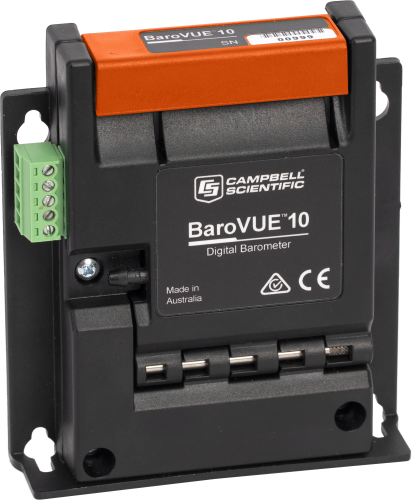
Product Line
| Pressure Range | Elevation | Temperature Range | 精度 | Current Consumption | |
|---|---|---|---|---|---|
BaroVUE10 |
500 to 1100 hPa | ~609.6 m (2,000 ft) below sea level (as in a mine) to 4,572 m (15,000 ft) above sea level | -40 + 6°0°C | — |
|
CS100 |
600 to 1100 hPa | ~609.6 m (2,000 ft) below sea level (as in a mine) to 3,657.6 m (12,000 ft) above sea level | -40 + 6°0°C |
|
|
Other Products
| Pressure Range | Elevation | Temperature Range | 精度 | Current Consumption | |
|---|---|---|---|---|---|
CS106 |
500 to 1100 hPa | ~609.6 m (2,000 ft) below sea level (as in a mine) to 4,572 m (15,000 ft) above sea level | -40 + 6°0°C |
|
|
092-L |
600 to 1100 hPa |
|
-40° to +55°C |
|
10mA @ 12 Vdc (typical) |
Retired Products
Documents
Brochures
Frequently Asked Questions
Number of FAQs related toBarometric Pressure Sensors:18
Expand AllCollapse All
-
It is possible that an older version of Short Cut is being used. Download the latest version of Short Cut.
-
When using SDI-12 or RS-232 communication protocols, the pressure measurement can be returned in hPa, kPa, mmHg, inHg, or PSI. Refer to the BaroVUE™10manual for more information. If different measurement units are required, refer to a conversion chart.
-
Contact your local Campbell Scientific office to purchase a calibrated BaroVUE™10sensor card (BVC10). After you receive the calibrated card, swap it with your current card, and mail it back to your local Campbell Scientific office. In this way, only one trip to the field site is required, and there will be no downtime for the sensor.
-
Campbell Scientific recommends calibration on a yearly basis. However, conformance to published standards or regulations may require this on a more frequent basis.
-
While the measurement is equivalent, the BaroVUE™10is not a drop-in replacement. Unlike the CS100 and the CS106, the BaroVUE™10is a digital sensor that communicates either via SDI-12 or RS-232. To use the BaroVUE™10in a system that previously used a CS100/CS106, the wiring and program will need to be changed, as it is a digital sensor.
-
Zero downtime/recalibration
The BaroVUE™10has been designed to allow for zero downtime recalibration during normal use. Other sensors on the market need to be taken offline and sent back to the manufacturer to be recalibrated, often for weeks at a time, resulting in loss of data and costing time and money.
In comparison, the sensor card of the BaroVUE™10is calibrated ahead of time and sent out to customers to replace the old sensor card, requiring only one trip to the field and no downtime.
Further to this, the design of the BaroVUE™10allows customers to remove and replace their sensor card quickly and easily without having to disassemble the equipment in the enclosure or having to send the product back to the manufacturer. There is no need to turn the device off to replace the card.
Highly reliable measurements
The BaroVUE™10sensor card employs multiple sensor cells with statistical analysis to produce an accurate, precise, and repeatable measurement as well as a data-quality metric. The customer can use this quality metric for tracking calibration cycles, planning, maintenance schedules, and detecting pre-fault conditions.
Low power
The BaroVUE™10is a low power device and can be kept running continuously. The BaroVUE™10does not require any power cycling, unlike other products in this category.
Very low noise
The BaroVUE™10uses direct-to-digital sensors, and no analog-to-digital reconversion takes place inside the barometer.
These factors, coupled with the multiple sensor cells, result in a reduction in noise when compared with analog sensors.
Campbell Scientific aesthetics and form
The BaroVUE™10has been designed with functionality in mind, and its aesthetic complements other Campbell Scientific products.
The BaroVUE™10can be mounted in the orientation that best suits the application and has a smaller backplane footprint than its competitors.
-
The BaroVUE™10can fit inside an ENC100. For more information, refer to the Specifications information on theENC100product page.
-
There is no warm-up time for the BaroVUE™10.
-
The quality metric is a unique diagnostic feature that indicates the quality of the pressure measurement returned by the sensor card (BVC10). It enables the user to monitor the health of their sensor to better schedule recalibrations.
Quality Metric Range Description Comments > 6
Sensor freshly calibrated
5 to 5.99
Sensor working well
4 to 4.99
In two to three months, this sensor will need to be recalibrated.
Within three months, send the BaroVUE™10 to the factory for recalibration.
0 to 3.99
Recalibrate the sensor now.
As soon as possible, send the BaroVUE™10 to the factory for recalibration.
-
In most cases, the enclosures or buildings where the BaroVUE™10is housed have enough ventilation for the pressure to stay at equilibrium with the ambient pressure. Therefore, the sensor does not need to be vented to the outside
However, if the sensor resides in an air-tight environment, and the pressure external to this environment needs to be measured, then the sensor will need to be vented to the outside. The preferred method for measuring the pressure external to the enclosure is to use a two-plate pressure port such as the RM Young 61002 to minimize dynamic pressure errors due to wind.
Privacy Policy Update
We've updated our privacy policy.Learn More

